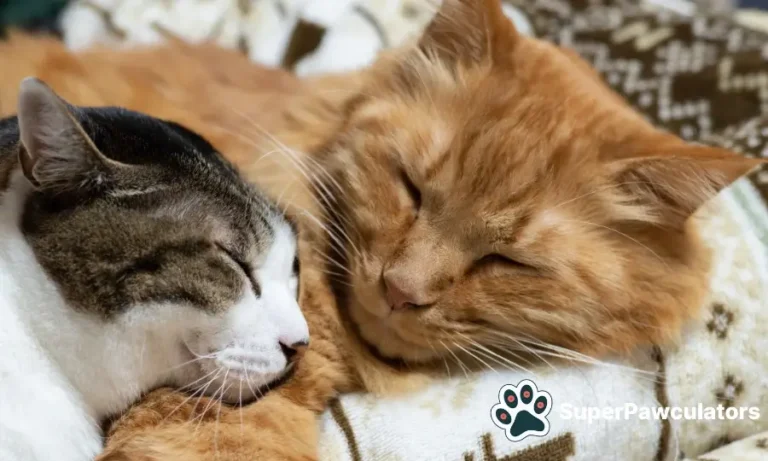Introducing a new cat into a home with existing pets can be a bit like trying a brand-new recipe – could be a total win, or, well, a total kitchen disaster. Many pet owners have learned this the hard way. Picture this: A resident cat, a big, fluffy Persian perhaps, meeting a tiny rescue kitten. It’s not always a meet-cute! Hissing, fur standing straight up, the whole nine yards – can often occur. It might seem as though the walls are about to explode with all the commotion!
Thing is, rushing a cat intro is like a recipe for pet chaos. It just stresses everyone out in the long run. Instead, patience is everything. Think of it as being a cat “matchmaker,” slowly setting the stage for your fur babies to meet peacefully. So, let’s talk about the real deal when it comes to bringing a new cat home—how to actually make it a good experience for all involved. This is a method that has proven to work to create a happy, calm, place for all your cats, new and old.
To help us create more feline tools and guides, this site contains affiliate links, which may earn us a small commission at no extra cost to you.
Why Cat Introductions Can Be Tricky
Why are cat introductions so tricky? Cats are territorial and creatures of habit. Introducing a new cat can disrupt their routines and boundaries, leading to fear and aggression. Think about it from their point of view: if someone suddenly moved into your space without permission, wouldn’t you be freaked out? The initial hisses, growls, and puffed-up fur are normal reactions. It’s crucial not to take it personally, but to manage these reactions to create a calm environment. Patience is the key! The biggest challenge in the cat introduction process is understanding their behaviors and not rushing the process. The goal is to create a low-stress environment for all cats involved, including the new cat.
Key Takeaway: Proper cat introduction is essential for a harmonious multi-cat household.
Step 1: Swapping Scents – Getting Ready for a New Cat
Before visual meetings, it’s vital to introduce the cats’ scents. This creates familiarity and reduces initial shock. This step is all about preparing for your new cat. Research from Ohio State University’s College of Veterinary Medicine highlights the importance of scent in cat communication.
Here’s what to do:
- Use a Towel: Rub a soft towel on the new cat to gather their scent, focusing on their face and neck.
- Scent Introduction: Place this towel near the current pets’ areas, and vice-versa, to let them get used to each other’s smell.
- Repeat: Do this for several days. This simple act starts the familiarity process and makes it much more manageable when they do eventually meet face-to-face. This initial scent swapping is one of the most crucial steps in preparing for cat introductions because it creates a sense of security for all of the cats involved.
Scent swapping creates familiarity and reduces stress.
Step 2: Meeting Through the Door – Seeing and Hearing Each Other
After scent swapping for a few days, move to visual contact – but still with a barrier. The doorway introduction is an amazing way to start.
- Closed Door Meetings: Have the new cat in a closed room, with regular short visits with current pets on the other side.
- Positive Associations: Feed both cats on opposite sides of the door so they associate the other’s presence with positive things, like food.
- Short and Sweet: Keep these meetings brief initially. The idea is to prevent anxiety and stress during cat introductions.
- Observe Reactions: Look for relaxed body language, and stop if you notice any aggressive behavior. If there’s hissing or aggression, revert back a step and continue scent swapping for longer before trying the door again. For information about stress signs in cats, see the American Animal Hospital Association guidelines on Understanding Feline Body Language.
Doorway introductions create visual and audio familiarity while keeping the cats safe.
Step 3: Seeing Through a Barrier – A Controlled Introduction
Now, it’s time for a visual introduction with a barrier that is see-through, but still keeps them separated.
- Use a Barrier: Use a pet carrier, baby gate, or screen door. These tools allow them to see each other, without physical contact.
- Longer Interaction: Supervise these interactions for longer periods, and look for comfortable body language.
- Distractions are Your Friend: Have toys, catnip, or a laser pointer on hand. This is an important step for creating a positive association for your new cat.
This is the next step in your journey to a successful cat introduction. This allows cats to get comfortable with each other at their own speed.
A visual barrier lets cats interact safely, which builds positive association and reduces potential fights.
Step 4: First Face-to-Face Meetings – Under Supervision
If all goes well, it’s time for supervised meetings in the same room. Choose a neutral space, where no one feels territorial, and remember to keep it calm and stress-free.
- Short Meetings: Start with very short meetings, 5 minutes at a time.
- Stay Calm: The owner’s energy will impact them. Be calm, patient and prepared.
- Intervene if Necessary: If things escalate, be ready to separate them. These steps are all about ensuring the safety of cats while they meet.
- Positive Associations: Have treats and toys ready for positive reinforcement. A guide from Edmonton Humane Society, suggests that “reward based training will not cause a fearful cat to become more fearful”.
Short, supervised meetings help cats learn to coexist.
Step 5: Living Together – Ongoing Management
Integration is a process, not an event. Ongoing management is key to a peaceful environment.
- Multiple Resources: Keep multiple litter boxes, food bowls, and water stations in different spots.
- Observe Behavior: Watch for changes in behavior or signs of bullying.
- Minor Adjustments: A little more space or time can help make a big difference if things are still difficult. This step isn’t just about cat introductions, but about maintaining long-term household harmony for all of your animals.
- Keep Learning: Remember, every animal is an individual, so adjust as needed. These steps will make a home a safe and comfortable place for everyone. Information on resource management can be found in “How to Create a Multi-Cat Environment” blog from Battersea.
Ongoing management is key for long-term success in a multi-cat household.
Common Mistakes and Helpful Tips
- Cats Will Sort It Out: One of the biggest myths is that cats will “just work things out.” They often need help, so please support them through this.
- Hostility Isn’t Hate: Don’t assume their initial hostility is malicious; it’s about establishing social hierarchy. So take it easy on them, it’s not personal.
- Know the Difference: Learn to tell when a cat is just annoyed vs. scared so one can help accordingly. These tips can help during cat introductions and beyond!
Understanding common misconceptions and expert tips will help you on this journey.
Conclusion
Introducing a new cat takes time and patience. But with a slow and steady approach, you’re setting the stage for a harmonious household. Remember, by following these tips and staying patient, you’re avoiding weeks of fighting.
How long does it typically take for cats to adjust to each other?
The adjustment period varies; some cats settle in weeks, others may take several months. The key is to be patient and not rush the process.
What are the signs that the introduction process is not going well?
Watch for constant hissing, excessive hiding, or decreased appetite, which are signals of stress. If you see these behaviors, slow down the introduction process or seek expert advice.
Is it ever too late to introduce a new cat to existing cats?
It’s not too late, but it may require more time and patience. A slow and deliberate approach is still important for older cats.
What should I do if the cats are fighting?
Separate them immediately to prevent injuries and distress. Then, go back a step in the introduction process, and make sure you provide separate spaces, resources, and if needed, consult a behaviorist.
Do all cats eventually accept each other, or is there a chance they will never get along?
While many cats learn to coexist, they might not become best friends. The focus should be on creating a safe space for everyone, rather than forcing friendship.

